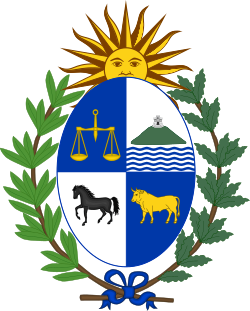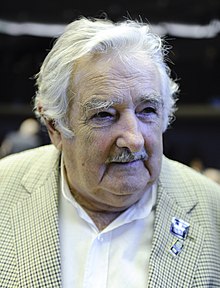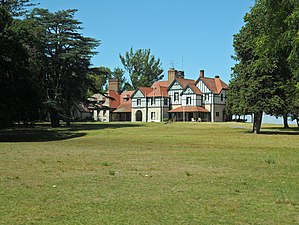President of Uruguay
The president of Uruguay (Spanish: Presidente del Uruguay), officially known as the president of the Oriental Republic of Uruguay (Spanish: Presidente de la República Oriental del Uruguay), is the head of state and head of government of Uruguay. His rights are determined in the Constitution of Uruguay. Conforms with the Secretariat of the Presidency, the Council of Ministers and the director of the Office of Planning and Budget, the executive branch. In case of absence, his office is exercised by the vice president. In turn, the president of the republic is the commander in chief of the Armed Forces.
| President of the Oriental Republic of Uruguay Presidente de la República Oriental del Uruguay | |
|---|---|
 Uruguayan Coat of Arms | |
 Luis Alberto Lacalle Pou since 1 March 2020 | |
| Residence | Residencia de Suarez |
| Seat | Executive Tower |
| Appointer | Popular Vote Election |
| Term length | Five years, not renewable immediately |
| Inaugural holder | Fructuoso Rivera |
| Formation | 6 November 1830 |
| Deputy | Vice President of Uruguay |
| Salary | 11,634 USD per month[1] |
| Website | presidencia.gub.uy |
 |
|---|
| This article is part of a series on the politics and government of Uruguay |
|
Executive
|
|
Legislative
|
|
Administrative divisions |
|
|
|
|
See also |
|
|
Since 1990, the president's term has begun and ended on March 1. This same date for ending the presidency also happened during the National Council of Government (1952–1967) and it has been not unusual since 1839. The current president since 1 March 2020 is Luis Lacalle Pou, the son of the 36th president, Luis Alberto Lacalle.
Features of the office
Requirements
The Constitution amendment establishes the requirements for becoming President. Article 151 establishes that the President must be a natural-born citizen of the country, or have been born to an Uruguayan citizen if born abroad. The President must also be at least 35 years old and be registered in the National Civic Registry.[2]
Election
According to the current Constitution Constitution of Uruguay of 1967 or Constitution of Uruguay of 1997,[3] the president is elected by direct popular vote for a term of five years. He may be reelected any number of times, but is ineligible for immediate reelection.[4] The president and vice president run on a single ticket submitted by their party. In case no candidate obtains an absolute majority of votes (50%+1), a runoff is held between the top two candidates. In this case, the candidate who obtains a plurality in the runoff wins the election.
Powers and duties
According to Article 168 of the Constitution, the president, acting with the respective minister or ministers, or the Council of Ministers, includes, is assigned:
- The preservation of order and tranquility within and security without.
- The command of all armed forces.
- The promulgation of all laws, issuing special regulations necessary for its implementation.
- The delivery, to the General Assembly of Uruguay at the opening of regular sessions, the state of the Republic address.
- The right to veto laws he dislikes.
- The right to propose bills or amendments to laws previously enacted.
- The dismissal of public employees for misfeasance, malfeasance or nonfeasance.
- Management of diplomatic relations and, with consent of the legislature, the right to declare war.
- The right to declare a state of emergency when needed.
- The preparation of the state budget.
- Negotiation of treaties with the ratification of the legislature.
Living former presidents

Julio María Sanguinetti
(35th & 37th President),
served 1985–1990 & 1995–2000
January 6, 1936
Luis Alberto Lacalle
(36th President),
served 1990–1995
July 13, 1941
José Mujica
(40th President),
served 2010–2015
May 20, 1935.jpg)
Tabaré Vázquez
(39th & 41st President),
served 2005–2010 & 2015-2020
January 17, 1940
Residence
The Suárez Residence in Montevideo is the official residence of the president. The site was acquired by Adelina Lerena de Fein at auction, and the construction of a three-storey house by the young architect Juan María Aubriot, was ordered by Fein Lerena family. In 1925, the young Luis Batlle Berres and Matilde Ibáñez Tálice met while walking in front of this property. Soon after they were married. In 1947, Luis Batlle Berres was already head of state, and at the suggestion of his wife they chose this mansion as their official residence.[5]
The Anchorena Presidential Estate is the president's country residence. Located in the Colonia Department, 208 kilometers from Montevideo, is the result of the legacy of the aristocrat Aarón de Anchorena who gave about 1,369 hectares of his estate to the Uruguayan State. The mansion combines the Norman and Tudor styles.[6]
- Presidential residences
 Residencia de Suárez, the official residence
Residencia de Suárez, the official residence Anchorena Presidential Estate, the official retreat
Anchorena Presidential Estate, the official retreat
References
- "Shocking Gap Between Latin America's Presidential Salaries And Workers Minimum Wage". Latin Post.
- "Constitución de la República Oriental del Uruguay". www.impo.com.uy. Retrieved 1 May 2020.
- https://web.archive.org/web/20150329211901/http://www.parlamento.gub.uy/constituciones/const004.html
- "Constitución de la República Oriental del Uruguay". www.impo.com.uy. Retrieved 1 May 2020.
- "Diario EL PAIS - Montevideo - Uruguay". historico.elpais.com.uy. Retrieved 3 August 2020.
- "Bush se reúne en Uruguay con el primer presidente de izquierdas del país | elmundo.es". www.elmundo.es. Retrieved 2 August 2020.
